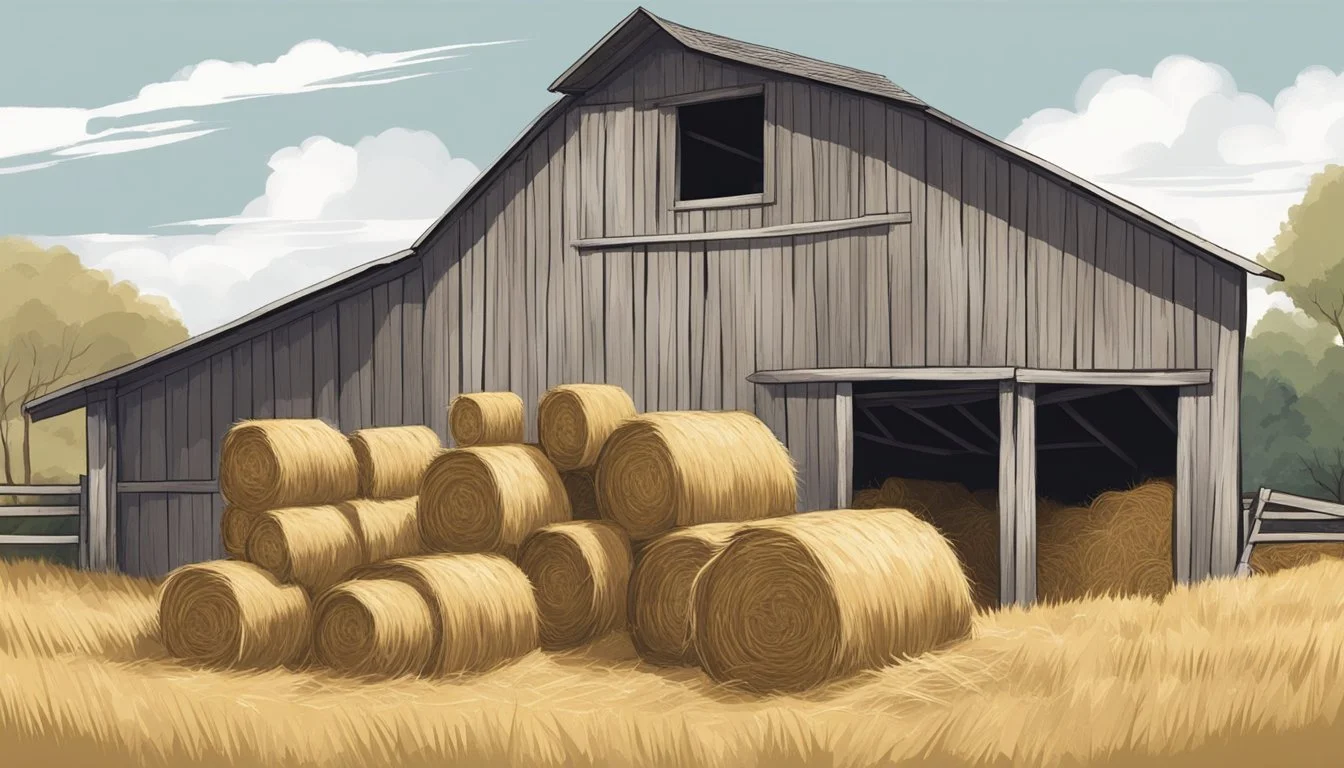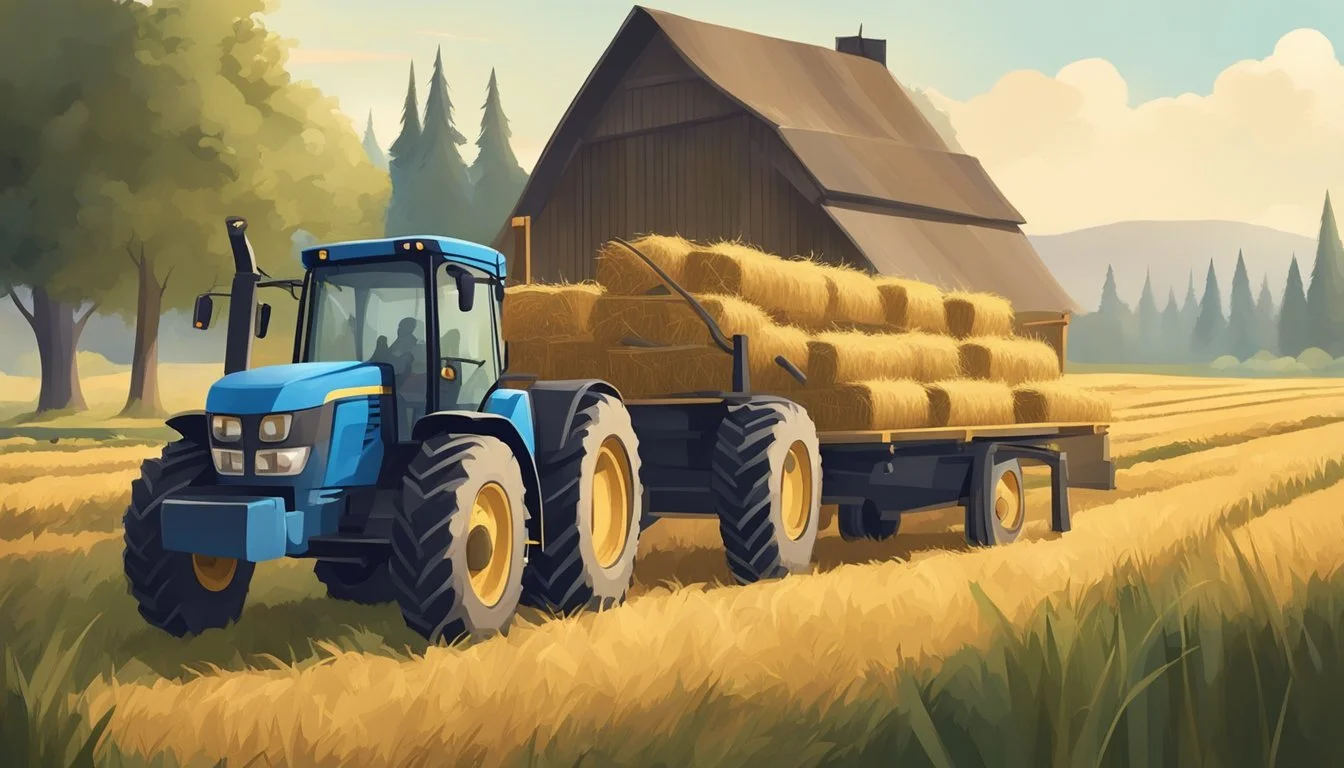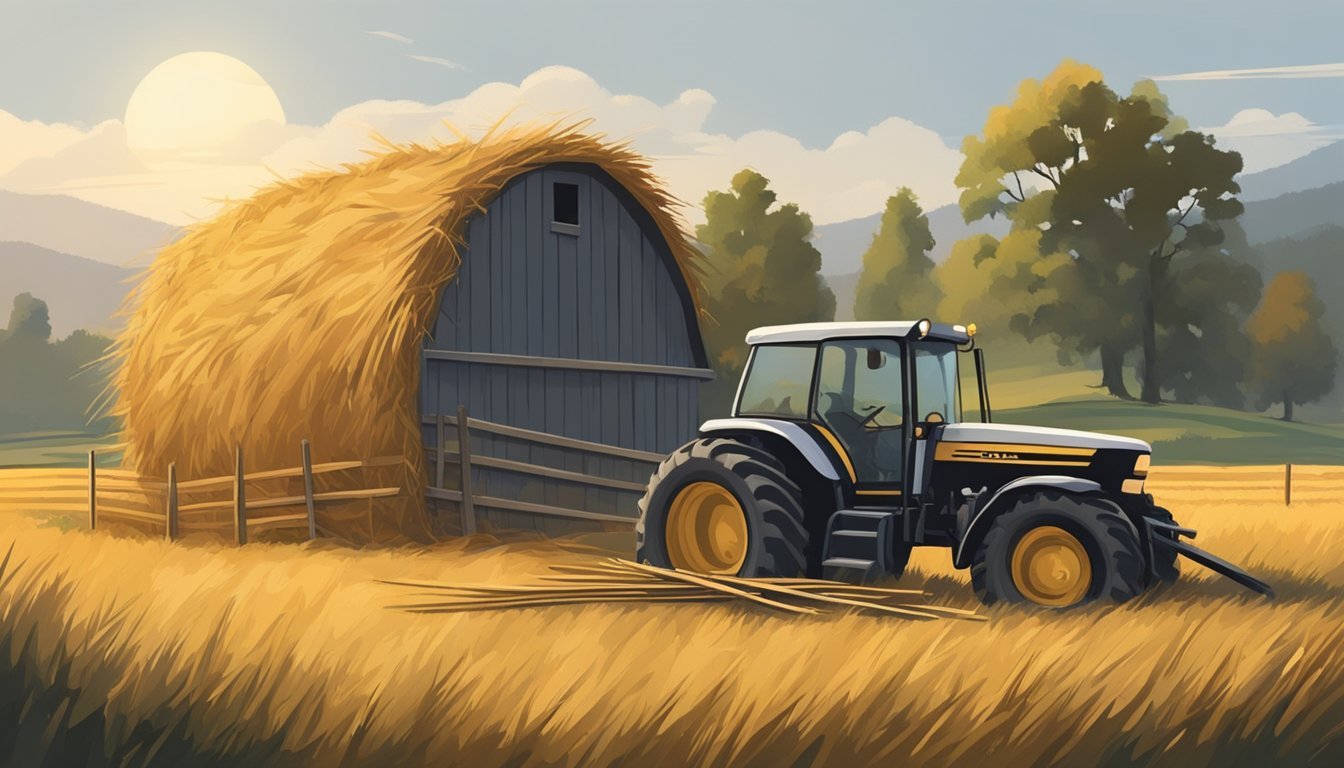Essential Hay Forks for Efficient Hay and Straw Handling
Tools for the Modern Homestead
Efficient hay and straw handling is vital to maintaining a well-functioning homestead. The hay fork is a critical tool for this purpose, allowing for the easy lifting and movement of these materials. With its various designs, from two to five tines or more, the hay fork serves multiple functions. It can handle not just hay and straw but also manure and garden waste, making it an indispensable implement for farmers and homesteaders alike. The design of hay forks, often featuring durable tines and a sturdy handle, ensures they can withstand the rigors of farm work while providing a good grip for the user.
A well-crafted hay fork, such as the Seymour 3-Tine Forged Hay Fork, typically has a contoured hardwood handle and a head sized for efficient material handling. The tines on these tools are crafted to pierce and carry hay bales without becoming entangled, streamlining the process of feeding livestock or bedding stalls. For enhanced productivity, hay forks are designed to move large amounts without straining the user, enabling quick and effective work.
Selecting the right hay fork for a homestead can significantly influence productivity. With the right tool, tasks such as moving hay for feeding, clearing manure from barns, or collecting garden debris become much simpler. The choice of fork — whether a traditional hand fork or an attachment for a tractor — depends on the scale of the operation and the specific needs of the homestead. It is an investment that can save time and effort, contributing to a more efficient and manageable agricultural establishment.
The Basics of Hay Forks
Selecting the right hay fork is crucial for effective handling of hay and straw. It ensures efficiency and eases the physical strain on the user during farming tasks. Understanding the differences in fork types, tine configurations, and balancing features is key for making an informed decision.
Understanding Hay Fork Types
Hay forks come in various types, each tailored for specific tasks. The common characteristic they share is a long handle, typically made of wood or metal, with a head consisting of several tines. Standard hay forks are designed with curved tines, ideal for moving hay bales. Heavy-duty versions have more tines made of steel or iron, intended to endure the rigors of farm work. Their tine count and shape vary depending on the design. When choosing a hay fork, one must consider the task at hand; for example, a pitchfork with fewer tines might be preferred for lighter, more manageable loads.
Choosing the Right Tine Length and Spacing
Tine Length: The length of the tines affects the fork's ability to penetrate a hay bale and its carrying capacity. Longer tines are suitable for larger bales, while shorter tines may offer more precision and control for smaller stacks.
Spacing: The space between tines is another critical specification that determines how easily a fork can slide into hay and how much material it can secure per lift. Close spacing can increase strength, whereas wider spacing makes it easier to penetrate and collect loose hay.
Determining the Ideal Weight and Balance
A hay fork's weight and balance are indispensable in evaluating its usability. A well-balanced fork feels more comfortable and reduces fatigue over time:
Weight: A lighter fork is typically easier to handle and suitable for quick, repetitive tasks. Conversely, a heavier fork can add to the tool's durability and may be more effective in handling compact or wet hay.
Balance: How the weight is distributed along the fork influences how it feels during use. The ideal balance point allows for a natural lifting motion, minimizing the effort required.
In summary, when selecting a hay fork, one must examine the types available, assess tine length and spacing based on the nature of work, and choose a well-balanced fork with a comfortable weight. Such attention to specifications will ensure that the selected tool aligns closely with the requirements of farming activities.
Material and Construction
Selecting the right materials and construction for hay forks directly impacts their durability and efficiency. It is imperative to understand the specifics of handle materials and tine fabrication, as well as customizable features that enhance handling equipment.
Wood Versus Steel Handles
Wood: Wooden handles provide a traditional feel with good flex and shock absorption. They are generally lightweight and comfortable to grip.
Steel: Steel handles offer superior strength and longevity. They are more resilient to bending and breaking under heavy loads.
Forged Versus Manufactured Tines
Forged Tines: Forged steel tines are known for their remarkable durability and strength, being less likely to bend or break during intensive farm work.
Manufactured Tines: While manufactured tines can be cost-effective, they may lack the custom shape and specific resilience of forged options.
Customizable Features for Efficiency
Customizable Options:
Tine Length: Custom tine lengths can match different bale sizes and shapes for more precise control.
Handle Shape: Ergonomically designed handles can improve comfort and reduce fatigue during prolonged use.
Focusing on these factors ensures that the hay fork is equipped to handle the demands of farm work with reliable performance.
Application and Use Cases
In managing a homestead, specialized tools are essential for different farming tasks, including handling hay and straw, dealing with manure, and maintaining high productivity levels in ranches and barns.
Effectively Handling Hay and Straw
Hay forks are crucial for efficiently moving and stacking hay and straw. They are designed with multiple sharp prongs—usually made of durable steel or iron—to pierce and carry bulky hay bales. The number of prongs can vary, but they typically range from three to six, providing the strength and stability needed for heavy lifting without damaging the materials.
Prong Material: Durable steel or iron
Prong Count: Typically 3-6 for optimal usage
Specialized Forks for Manure and Gardening
When it comes to manure management or gardening, a different type of fork is often used. Manure forks may have a similar shape to hay forks but are specifically designed to handle heavier and denser materials. Their robust construction ensures they can withstand the corrosion and odors associated with manure, making them indispensable for maintaining livestock areas clean and sanitary.
Usage: Manure management, garden maintenance
Features: Corrosion resistance, odor control
Enhancing Productivity on Ranches and Barns
The right equipment can greatly enhance productivity on ranches and barns. Hay and manure forks improve the efficiency of feedlot operations and ranching applications. Their design allows for precise control, making hay, straw, and manure handling more manageable and less time-consuming.
Benefits: Precision, efficiency, time-saving
Application Areas: Feedlots, ranching, barn maintenance
In every task, from moving hay to managing manure, the selection of the appropriate fork can have a substantial impact on a homestead’s productivity and the well-being of livestock.
Maintenance and Replacement
Proper maintenance extends the life of hay forks, and timely replacement of parts ensures they remain safe and effective for hay and straw handling. Addressing the wear and tear of the tools is essential for smooth homestead operations.
Regular Cleaning and Care
Regular cleaning is crucial to maintain the integrity and functionality of hay forks. Users should remove debris and dirt after each use to prevent the build-up, which can corrode metal parts. A stiff brush can be effective for cleaning the tines. It's important to inspect the hay fork for signs of rust or weakness in the metal. In case of rust, one can use a wire brush or sandpaper to clean the area. After cleaning, applying a thin coat of oil protects the metal from moisture and rust.
Cleaning tools:
Stiff brush
Wire brush or sandpaper
Cloth for oil application
Protection:
Apply oil to metal parts
Replacing Worn or Damaged Tines
Tines may become bent or damaged over time, and this affects the performance of the hay fork. Homesteaders should check for signs of damage and replace the tines when necessary. To replace a tine, they may need to use a vice to secure the fork head and a hammer to carefully remove the old tine. Ensuring the replacement tine matches the exact shape and size of the original will maintain the balance and effectiveness of the tool.
Tools required for replacement:
Vice
Hammer
Replacement steps:
Secure fork in vice
Remove old tine with hammer
Match and install new tine
Attachment and Handle Replacement
The handle and its attachment to the fork head are also subject to wear and should be checked regularly. A loose or cracked handle can cause inefficiency and be a safety hazard. If the handle needs to be replaced, the old one should be removed from the fork head, sometimes requiring a hammer if it's wedged tightly. When selecting a new handle, it’s important to choose one with a comfortable grip and that is the correct length for the user to maintain proper leverage and control. Reattach the new handle securely to the fork head, ensuring it is aligned correctly.
Handle considerations:
Comfort
Length
Grip
Attachment process:
Remove old handle
Choose and attach new handle
Align properly and secure
Ergonomics and Handling
Selecting the right hay fork involves considering ergonomics and handling to ensure the task is performed efficiently and safely. A well-designed hay fork can significantly reduce the physical strain on a user during hay and straw handling on the homestead.
The Importance of a Comfortable Grip
A comfortable grip on a hay fork is paramount to minimize hand fatigue and improve control. The user should look for a handle that is designed to fit comfortably in the hand, often wrapped in a non-slip material or shaped to conform to the grip. Ergonomic handles contribute to a better grip, allowing for longer periods of work without discomfort.
Length and Reach for Safe Lifting
The length of the handle plays a crucial role in providing the appropriate reach and leverage, which helps to ensure safe lifting techniques. An optimally sized handle allows the user to stand upright while lifting, reducing the risk of back strain. Hay forks with long handles can provide adequate reach to lift and turn large volumes of hay with minimal effort, promoting safe and effective working postures.
Tools for Enhanced Handling Efficiency
To enhance handling efficiency, various handling equipment are designed to work in tandem with hay forks. Tools like bucket forks and bale huggers can handle large round bales, streamlining the process of moving and stacking. These additions equip the user to handle hay more quickly while exerting less effort, thereby increasing productivity on the homestead. The use of these tools also translates to less physical strain, as they often include features that evenly distribute the load during transportation and storage tasks.
Additional Tools and Accessories
In the pursuit of hay and straw handling efficiency, selecting the right supplementary tools and maintaining optimal loading systems are crucial. Custom-crafted tools by artisans may also contribute to the effectiveness of these tasks.
Choosing the Right Rake or Pitchfork
When managing small to medium-sized batches of hay, rakes and pitchforks are indispensable. A rake is useful for gathering hay into piles or windrows, while a pitchfork with multiple tines is beneficial for picking up and turning over hay to promote drying:
Rake Types:
Metal Rakes: Durable for heavy-duty use
Plastic Rakes: Lightweight for quick work but less durable
Pitchfork Differences:
Number of Tines: More tines handle larger loads but require more strength
Material: Forged steel forks offer long-lasting toughness
Utilizing Barrows for Heavy Loading
For transporting larger quantities of hay and straw, wheelbarrows or garden carts come into play. They help to move heavy loads with ease and efficiency:
Barrow Types:
Single Wheel Barrows: Better for maneuverability in tight spaces
Twin Wheel Barrows: Provide more stability under heavy loads
Loading Considerations:
Volume Capacity: Choose a barrow that can handle the bulk of your materials
Weight Limit: Ensure the barrow can support the weight of wet or dry hay
Collaborating with Artisans for Custom Tools
Sometimes standard tools do not meet the specific needs of a homestead. Collaborating with artisans can result in tailor-made tools for specialized tasks. These custom tools can lead to a significant increase in productivity and ergonomics:
Customization Examples:
Extended Handles: For taller users to avoid back strain
Reinforced Tines: For greater durability with heavy, dense material
By incorporating the right assortment of additional tools and accessories, one can significantly enhance the efficiency and ease of hay and straw handling, ensuring a productive and smooth operation on the homestead.
Conclusion
Selecting the right tools for hay and straw management is critical for an efficient homestead operation. Hay forks are a staple, offering versatility for various tasks, including the transport of hay and distribution of straw. They come in different designs, with dimensions that cater to the specific needs of the user. For instance, a manure fork might also serve in handling compost materials, enhancing its utility beyond just hay and straw.
Durability is a key factor, with many hay forks featuring ash handles known for their strength and flexibility. The number of tines on a fork can vary, with two to five being most common. Fewer tines mean easier penetration of the hay pile, while more tines offer better control and handling of the material.
In summary, the right hay fork helps maintain productivity in farm operations. The tool’s dimensions and handle material should match the task at hand for maximum efficiency. When utilized correctly, hay forks significantly improve the process of hay management, making them an indispensable tool for homesteaders and farming professionals alike.
The bottom line is for buyers to assess their needs, understand the range of available options, and choose a hay fork that enhances their workflow and withstands the demands of farm work.








